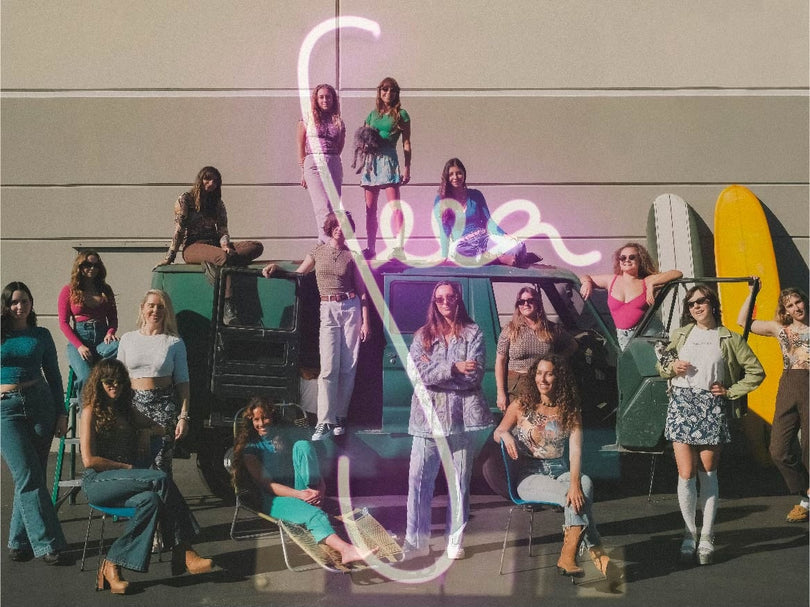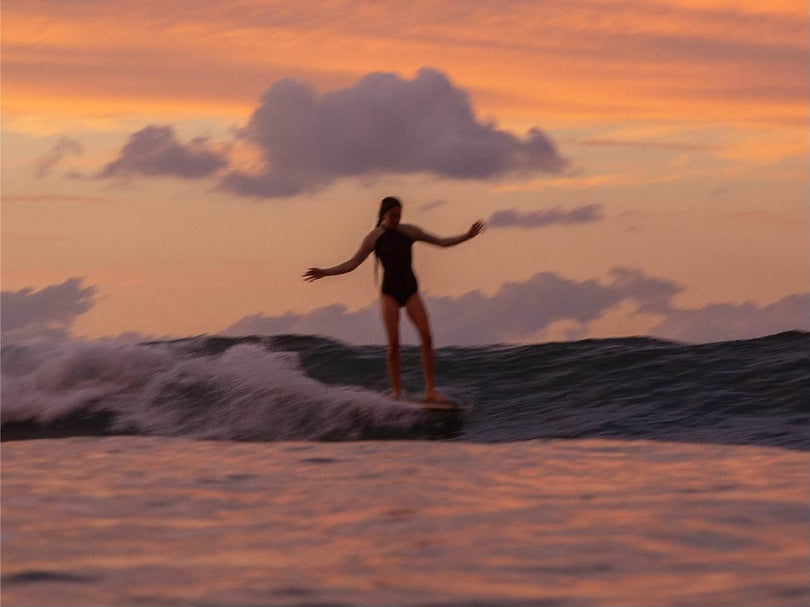 |
| Christine Brailsford, at one with her craft. |
As one of the few women who have answered the call to shape surfboards, Christine Brailsford infuses a feminine finesse into the contours of every surf craft she creates. Christine’s passion for sculpting started with wooden paipo belly boards and wooden handplanes about five years ago.
She transitioned to carving foam at the special request from a friend. After shaping her friend a 6’0” stubbie single fin and a 5’9” for herself, it was like catching a first wave high all over again. “I had found what I wanted to do for the rest of my life,” Christine says about shaping. “It was a feeling like I had found the beginning and the end of it all.”
Today, she sands down wood and makes surfboards under the names Whomp handplanes and Furrow surfboards, respectively, and is most-likely seen with a Corgi named Ted that she co-guardians with her fiancé Manuel Caro of Mandala surfboards.
 |
| Christine and Ted the shop dog. |
We love Christine’s grom-like stoke, humble attitude and minimalist aesthetic so much that we commissioned her to create the very first Seea surfboard in collaboration with Seeababe Mele Saili!
Read on to discover more about Christine’s shaping journey and come see her live in action at Shaper Studios in San Diego this Saturday, February 22!
 |
| From left to right, Christine then as a grom and now, somewhere in Santa Barbara. |
How did you get into surfing?
When I was 11-years-old, I begged my mom to let me go to the YMCA surf camp to learn how to surf. I was always fascinated by surfing and surfboards from a young age. Up until then, my mom would take my brother and I to Ponto Beach in the summer to bodyboard and play in the water.
My parents helped me buy my first surfboard, which was a 6’8” pintail thruster. I struggled with that board. I realized that I had a huge learning curve with it and started to dream of a board that would be easier to ride. Not having any family that surfed, I remember studying Surfer magazine and going to surf shops, totally mystified. I was always drawing and surfboards began to fill my sketchbooks.
I remember guys telling me that girls need to ride really long short boards, but I dreamed of a shorter, wider board that would be fast, easy to catch waves, and duck dive. I must have seen it somewhere, but I drew a fish with a round nose one day. I wanted to get a board like that. I saved up all of my allowance and birthday money and traded my board so that I could buy a new board. I found a 6’1” yellow Nectar twin fin at the old Leucadia surf shop, and surfed that board throughout high school. It was really too big for me, but I learned how to surf and grow with it. All the while, I kept drawing and dreaming of boards.
 |
| Twin fin by Furrow surfboards. |
How do you describe the style of your surfboards and the kind of boards that you shape?
Living here in Encinitas, the surf is fun, but on an everyday basis it’s waist to shoulder high, waist to knee high. I find those stubbie boards to be a really fun way to ride a shorter board, but be able to catch waves easily, turn, have a lot of drive, and also have this surfboard broken down to its most simple and functional form.
I love the aesthetic of simplicity and focusing on the shape and the form. With my boards I keep them clean glass, clean color. With my design and art that I put on them, its very minimalist, just focus on the form and purity of it. I’ve always enjoyed that aesthetic. The customers that I build boards for, they understand that. I want to keep focusing on the design and the form and not have anything take away from it.
 |
| Anne Howe on a Whomp paipo shaped by Christine Brailsford. |
You started out shaping with wood. What kind of history comes with shaping with wood?
I began to study ancient Polynesian culture and surf craft, when I first learned about paipo. Paipos, traditionally made from Koa wood, are ridden prone or on your belly and are the first recorded surf craft used by common people in Hawaii. Though my first "board" that I shaped was an alaia-like board made out of 9-inch plywood —which didn't work at all because it was so stiff — paipos are where I started my shaping roots.
 |
| Whomp wooden handplanes and illustration by Christine Brailsford. |
What is special about shaping with wood?
The uniqueness of wood makes it very enjoyable to work with. The relationship of taking something from nature and repurposing it into something to ride waves is pretty special. When riding a wooden craft, there is a strong connection to nature and the past. I enjoy working with foam too, but would definitely like to shape a surfboard out of wood one day.
 |
| Whomp paipos shaped by Christine Brailsford. |
What is the story behind the name of your company, Furrow?
In farming, furrows are the [trench in the] ground that they plow to plant the seeds... Growth and renewal — that’s the big idea of the name. My ancestry are farmers from England and that’s where the logo derives from.
[In my art,] I have a lot of circle carving lines that are interwoven. That’s how I developed the idea for Furrow, because the idea was that each experience that we have, either small or large or somewhat insignificant all build upon each other to create who we are and where we’re going. I like to think about that kind of stuff in life and in surfing. Surfing for me is a personal thing and it’s a fun thing. It helps me meditate. It’s kind of like these pathways that combine to create the bigger picture.
 |
| Christine at work, carving. |
You also have an arts education, how does that play into your shaping?
My formal education is from the Laguna College of Art and design, where I graduated with a BFA in illustration. My college degree helped has not really helping me in my shaping, but more with my other job, which is freelance illustration and design. I have always loved sculpture, particularly reductive sculpture. As a reductive medium, shaping surfboards is the most challenging and rewarding medium that I have ever worked with.
What does it feel like to be one of the few women shapers? Why do you think there aren't more women shapers?
I feel extremely privileged shape to boards for people. Bringing joy to others through my craft is what drives me to shape a better board every day. There are a lot of women shapers out there who aren't as recognized as men and I feel fortunate to be one of them.
 |
| Mele Saili painting the deck of our first custom surfboard, shaped by Christine for SEEA. |
What is the story behind the board that your are making with Mele for the event at Shaper Studios and how does it suit her style?
I am working on two boards for Seea right now. The first is a 6'4" single fin stubbie, which Mele hand-painted and will be on display at her show. It is a v-bottom with hull nose entry and tucked under edge. The wide point is behind center which brings the pivot point closer to the tail. This lets you turn the board easier, with more subtlety and grace: both are characteristic of Mele's style.
The second board, that I will be shaping at the event, will be a 5'6" round nose twin fin fish. It combines the California fish template blended with a full stubbie round nose. It is a board that I have been working on to have a fun, easy to ride, skate-y feeling board for typical days that we have here in Encinitas.
 |
| Shakamuchacha Christine! |
Thank you Christine! We are beyond excited for the first Seea x Furrow surfboard!
Amped to learn how to shape your own board? Say hello Christine in person and learn more about getting started on shaping your own board at Shaper Studios this Saturday in North Park, San Diego.
 |
| See you there! |




